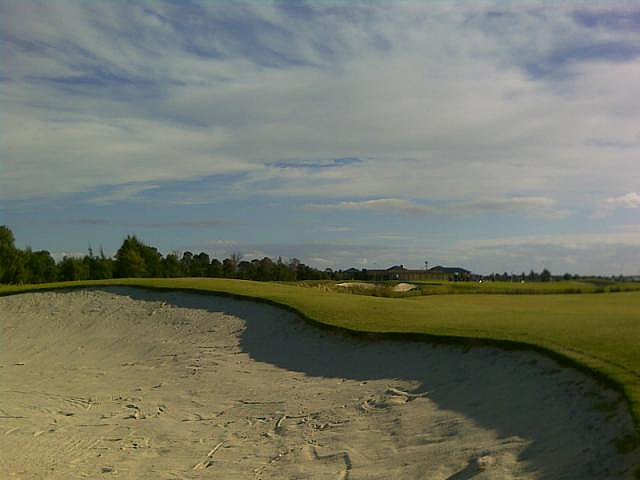Golfstead is reader-supported. When you buy through links on the site, we may earn an affiliate commission at no extra cost to you. Our affiliations include, but are not limited to, the eBay Partner Network and Amazon Associates.

Most people starting out in the game of golf put a disproportionately large amount of focus and time on hitting their woods off the tee and their irons off the short grass.
This shouldn’t be surprising. After all, it’s typically all you can do at the driving range.
But because of the lack of access and opportunity for the average person, the short game tends to be woefully neglected, and this includes bunker play.
On average, you will be faced with at least a few shots out of the bunker in any given round of golf. Learning how to properly play your bunker shots is critical for scrambling and avoiding bogeys or worse.
In this article, we’ll go over the fundamentals of how to hit out of the bunker, whether it’s a fairway bunker or greenside bunker, so you can take one major step towards having a sound short game.
Hitting A Bunker Shot
First, it’s important to make the distinction between fairway and greenside bunkers.
When you are in a greenside bunker, you’re typically about 5-50 yards from the hole near the green, and when you’re in a fairway bunker, you’re obviously much farther away. As you might suspect, the technique needed for each type of shot is different.
Let’s get right into it, starting with the greenside bunker.
The Greenside Bunker Shot

If played correctly, the greenside bunker shot is the only golf shot where you’re not actually “hitting” at the ball.
The basic idea with this shot is to hit a couple of inches behind the ball (typically two), going underneath the ball through the sand and letting the sand itself lift the ball into the air.
Funnily enough, amateurs often perform this shot well because most tend to hit behind the ball as it is.
There are a couple of things you should note if you want to be a good bunker player:
1. Use more bounce and less leading edge.
Bounce refers to the quality of an iron or wedge that determines how far the leading edge sits above the ground at address.
With a high bounce, the leading edge of the wedge is farther off the ground. This is what we want with normal (not buried) greenside bunker shots because it helps prevent the club from digging into the sand instead of sliding under the ball.
Fortunately, sand wedges are typically designed with high bounce for this very purpose. They also have a high loft (54-58 degrees), making them ideal for most bunker shots you’ll face.
If you find that you’re consistently digging into the sand with your bunker shots, you can either open the face or use a wedge with even higher bounce.
2. To hit it farther, hit closer to the ball.
The farther you want to hit your bunker shot, the closer you should hit behind the ball.
This is because the closer you hit behind the ball, the more the clubface is able to transfer the energy of the swing to the ball rather than relying on the indirect effect of moving sand.
If you want a higher trajectory, open your clubface and adjust your alignment (to the left for a right-handed golfer) to compensate.
It’s also worth noting a secondary effect of hitting closer to the ball: increased backspin. With a high enough clubhead speed, this can help the ball stop after one hop or even spin back, thus mitigating some of the effects of the increased distance.
Some Tips
It’s important that you follow through and don’t stop your swing when your club enters the sand, as this will allow the sand underneath the ball to launch it into the air. Try focusing on making a high finish with your swing.
If you are struggling to hit behind the ball, you may find it helpful to:
- move the ball forward in your stance
- not shift your weight forward as much in the downswing
It will take practice to be able to judge how far behind the ball your club should enter the sand and how full your swing should be, but as long as you keep these basics and tips in mind you should eventually find success.
The Fairway Bunker Shot

Unlike with a greenside bunker shot, you do not want to hit behind the ball; the fairway bunker shot is more similar to an iron shot from the fairway in that you want to hit the ball first.
While highly skilled golfers, particularly those with a shallower swing arc, can often “pick” the ball out of the bunker while only disturbing a few grains of sand, amateurs should focus on hitting down on the ball and taking a divot after.
If you happen to be far away from the green (200+ yards) and want to use a long iron, you should be careful that you don’t hit the lip on the way out and end up back in the sand for your next shot. Sometimes you are just better off taking a more lofted club and laying up down the fairway.
Don’t Load Your Legs
One of the big no-no’s of fairway bunker shots is driving or “loading” your legs during your swing. If you do this, you’re liable to sink into the sand and end up hitting the ball fat.
If you tend to have a lot of lower body action in your downswing, you might need to adjust your swing in fairway bunkers by using relatively more of your upper body.
What a lot of skilled golfers do is actually push their feet into the sand a couple inches in order to get a more secure stance, and then choke down slightly on the club. This makes unintentional sinking during the swing less likely.
Butch Harmon recommends standing taller at address and keeping your height throughout the entire swing. He also recommends swinging “easier” and accelerating the club through impact.
David Leadbetter, a leading golf instructor, recommends looking at the top or the front of the ball and making a three-quarter swing in order to catch the ball solidly.
A Note On Plugged Lies

A plugged lie, also called a buried lie, happens when the ball comes into the sand with sufficient speed and a steep enough descent angle to partially bury itself. You might see the top half of the ball surrounded by a small crater of sand, which is why this type of lie is often called a “fried egg”.
Plugged lies can also happen when a ball rolls into a previously existing depression in the sand or when it impacts the side of a bunker right near the lip.
The goal with plugged lies is to aggressively stick the toe and the leading edge of the club into the sand right behind the ball. Because you need to dig a little to get the ball out, you generally won’t have much of a follow-through, and that’s okay.
- Take a wide stance for stability and put the ball back in your stance.
- Square or slightly close the face to ensure that the heel doesn’t lead the toe through impact.
- Make a half swing while cocking your wrists.
- Come into the sand fast and steep right behind the ball.
If you can get the leading edge underneath the ball, the small amount of sand between the club and the ball will explode out and take the ball with it. With experience, you’ll learn how far behind the ball to strike so that you achieve the right balance between hitting it too fat and too thin.
The best you can usually hope for with plugged lies is to advance the ball down the fairway (if in a fairway bunker) or get the ball somewhere on the green so that you have a putt at it.
What equipment is best for the job?
A solid set of wedges, such as the G425 or G430 from PING, is usually sufficient for handling all types of bunker shots.
For normal bunker shots that are sitting cleanly on top of the sand, a good sand wedge with bounce is all you need.
For plugged lies in the bunker, however, you might consider using a wedge with low-medium bounce. The lower bounce is beneficial because it helps get the leading edge down underneath the ball.
Wedges with lower bounce like the lob wedge and gap wedge are also good to use when the sand is wet and compact, as this type of sand can make bounce more pronounced.
Conclusion
Whether it’s a regular lie or a plugged lie, hitting out of the bunker is relatively straightforward once you know the general technique.
Many amateurs and even beginner golfers can hit decent shots out of the bunker without much practice, because it’s usually easy to hit behind the ball. The challenge lies in hitting the sand at just the right distance behind the ball to produce the results you’re looking for.
But if you want more than just general tips for hitting out of the bunker, I have something for you. This will help you develop the ideal golf body in six weeks and improve every aspect of your game including bunker play:
Are you struggling with bunker shots? How good is your bunker game? Feel free to share your story and experiences in the comments below.




